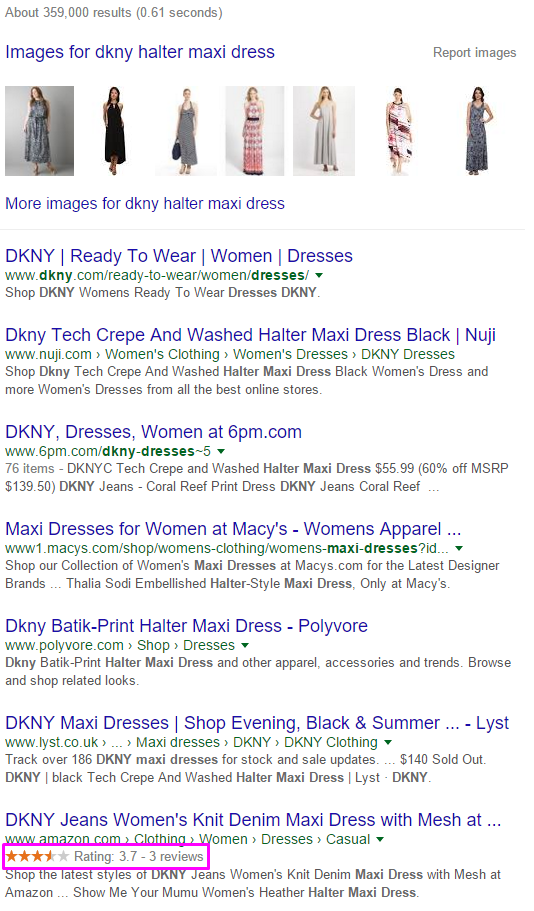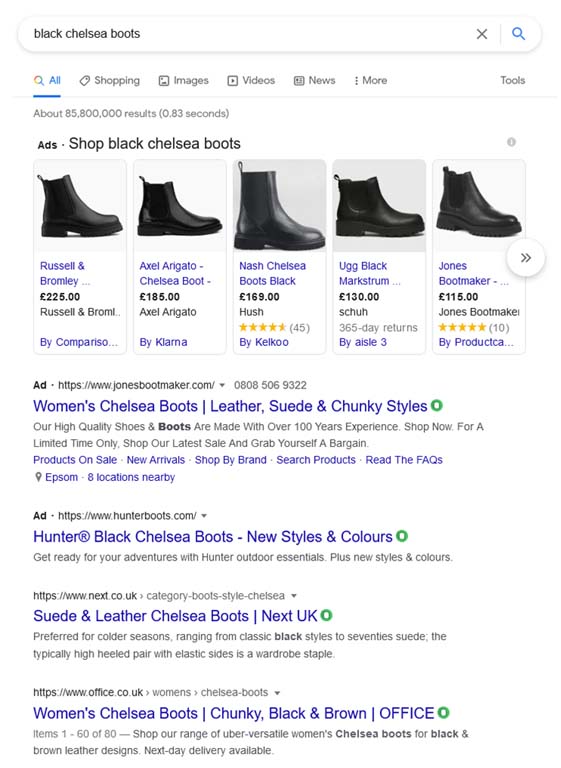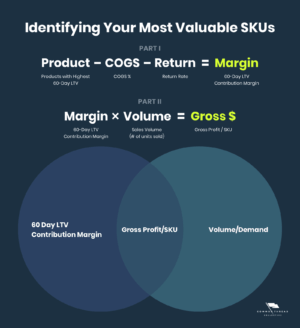As eCommerce SEO specialists our focus in the organic team at ThoughtShift is on ensuring that e-tailers get traffic from potential customers at different phases of their buying cycle and that this traffic converts. As a result we frequently find ourselves recommending the implementation of product review functionality.
There are two main SEO benefits to onsite product reviews:
1. Organic Click-Through Rate
On-page product reviews can have schema mark-up code added to generate Rich Snippets which are pulled through into the search results. This adds extra meta data to your organic search listing:

The benefits of this being that your listing takes up more space on the search results page, the stars are a different colour and draw the searcher’s eye. Additionally the stars convey to the searcher trust in your brand from seeing that people have indeed bought and received products from you and have left a review. All of these factors ultimately increase the likelihood that the searcher will click on your result, rather than one without any star ratings displayed even if you rank lower than them. Organic click-through rate is an important ranking factor as if Google can see that your result is getting a lot of traffic, even though it is ranked at position 4, it will assume that your site is what searchers are looking for and as a result move it higher up the search results.
2. Conversion Rate
Star ratings and product reviews on the product page are important trust signals to users that can help them to make the decision to buy now, rather than going away and thinking about whether to buy from your site or not. This is important for eCommerce SEO because:
- We want our traffic to generate sales!
- Perceived trustworthiness and conversion rate are metrics from the original Google Panda Update which are constantly being refined and rolled-out by Google to effectively rank websites
Indeed, according to a post by James Perin, Digital Communications Specialist at Feefo “even a product with a one star review has 107% more chance of selling compared to a product with no reviews”.
Common Objections
Despite the clear SEO benefits of this additional information on the product page, not to mention the commercial ones, many eCommerce sites do not have or effectively utilise product review functionality on their websites. Below are some common objections that we encounter and my response to those.
1. The cost of building review functionality into the site isn’t worth it
If your website has been built on an eCommerce intended platform then a reviews plugin should be easy and relatively cheap to install and use. If you have a legacy or custom coded site then this is probably the only objection that I can’t counter, except to say that when it comes to upgrading your website you should make sure that this functionality is part of the spec.
2. Stock turnover is too high to bother, by the time the reviews come through we’ll be sold out
If it is true that by the time you have sold, shipped and followed-up with customers on their purchases the product is no longer in stock then brilliant – your marketing is so good you don’t need to bother! But in reality this is unlikely. Some products will sell-out more quickly than others. Some will linger and go to sale and hang around in the sale for months on end. So really, a few reviews on how great it is could quickly free-up space in your stock room. But don’t wait until it is reduced to try and get the reviews, get it selling at full price in the first place.
3. We don’t have time to manage all that
A little bit of work getting the right systems in place can make the entire process automated and therefore take no time at all! All you need is a template set up in your email marketing software and a link to your database so the customer is automatically sent the email a pre-defined number of days after the order was completed. This is something that your Customer Service team can then oversee as part of their existing responsibilities.
4. What if the reviews are bad
If the product is going to incite bad reviews then they’ll get out there anyway through social media. At least if people leave the reviews on your product page then you are in a position to counter them in the product page copy. Once they are on Twitter, Facebook etc. they are in the public domain and out of your control. In reality products will get mixed reviews, by their very nature product reviews are subjective and the tone of them will depend hugely on the customer’s expectations of the product when they bought it. If you feel that your products might qualify for mixed reviews add some qualifying elements to your review functionality. For example, if you are selling flat-pack furniture your review questions could be:
- Age
- Gender
- Experience building furniture: A bit useless, OK, I get by, Semi-professional
- Star rating
- Review
This will give context when one person says that the doors don’t hang straight but they ticked the OK option for experience building furniture.
5. We don’t want to give away discounts/competition prizes for reviews which will be gone in 6 months
I completely agree, don’t! An efficient follow-up system will get you product reviews for nothing. The only reason to offer a discount or competition prize would be to get them to buy something else in order to boost sales, but rather than just giving it to them get something out of it too.
6. It doesn’t look very good having only 1 or 2 reviews on a product, or only having reviews on 1 or 2 products
It really doesn’t matter. As has been explained above 1 product review, with the correct schema mark-up code, can make a big difference to your SEO performance so it definitely adds value. If this is only on a few products then those products will benefit. As the website owner you know that there are only reviews on a few products, your customers won’t check…
7. I would be worried about our delivery service bringing the overall review down but we can’t change it
There may be elements which are out of your control that could have a negative impact on customer experience and therefore review quality. Equally, you could be worrying and it isn’t really a problem. The best way to pre-empt this kind of concern is to have different elements that the customer can rate out of 5 stars, such as:
- Buying experience
- Delivery
- Packaging
- Product
Followed by an overall star rating and a review. This will give context to the review and help you to understand your customer’s experience with your brand.
In light of the above I wholeheartedly recommend that eCommerce websites utilise product review functionality to improve their SEO performance and to increase conversions from all traffic sources.
Follow my contributions to the blog to find out more about digital marketing strategy, or sign up to the ThoughtShift Guest List, our monthly email, to keep up-to-date on all our blogposts, guides and events.






